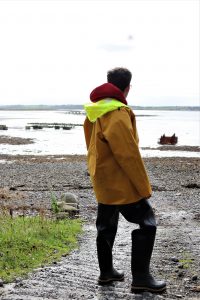What Does ‘Oilskin’ Mean?
Oilskin is a heavy cloth material which has been made waterproof by being impregnated with a mixture of hot wax, oil and gum and is the traditional foul weather wear favoured by fishermen and sailors.
When Were Oilskins Invented?
The expression ‘necessity is the mother of invention’ can be applied to the invention of oilskins. In the nineteenth century sailors sprayed themselves and the clothes they wore with oil to protect them from the harsh conditions at sea and the ocean spray. A sailor from New Zealand called Edward Le Roy is credited with the idea of using old sail canvas painted with a mix of linseed oil and wax for waterproofing which forms the basis for today’s oilskins. After repeated applications of linseed oil the clothing acquired a yellow tinge and this is still the colour most closely associated with oilskin material.
Ref. https://fashion-history.lovetoknow.com/clothing-types-styles/oilskins
1. How To Repair Oilskins:
- Put some tape over the hole on the outside of your oilskins to hold the tear in place
- Turn the oilskins inside-out
- Cut your patch – circular or oval shapes work better than squares which can snag
- Make the patch around 4-5cm bigger than the tear
- Using a marker draw a circle the same size as the patch around the tear, this will be your guide when painting on the glue
- Paint glue on both the patch and the torn oilskin
- When the glue is tacky tap down the patch and wipe in all 4 directions to make sure you have gotten rid of all the air bubbles
- Paint a small layer of glue around the edges of the patch
- When the glue is dry turn the oilskins the right way around and remove the tape. If the tape sticks use acetone to help you release it
- If it is a bad tear you might consider using the glue on the outside as well.
Guy Cotten produce a repair kit that includes patches in a range of colours and a tin of adhesive glue.
2. How To Care For Your Oilskins:
It’s important that your oilskins are regularly cleaned down and allowed to dry off to keep them in top condition and to avoid developing a musty smell or mildew.
 In general 4 simple steps will ensure that your oilskins remain in top condition:
In general 4 simple steps will ensure that your oilskins remain in top condition:
- Soak your oilskins in a bath of cold water. If you have fresh water on site you can hang them up and hose them down easily
- If there is dried on soiling you may need to give that a brush down with a firm brush
- Rinse again with clean cold water
- Leave the oilskin to dry naturally – make sure that you have good air circulation to speed up the process. Don’t hang in direct sunlight as this will degrade the waterproofing.
While some PVC-based fabrics (such as Guy Cotten Cap Coz and Nylpeche fabrics) can be machine-washed at 30° we would recommend washing by hand to prolong their shelf life. Never tumble-dry your waterproofs.
If your oilskins have been stored while still wet, in a damp or humid location, or not used for an extended period they can develop mildew. Cleaning off mildew is best done outside.
3. Removing mildew from oilskins:
- Make up a solution of 1/3 white vinegar and 2/3 fresh cold water
- Apply this to the mildew with a spray bottle or using a firm brush
- Scrub both sides of the oilskin with the vinegar solution
- Rinse off with clean fresh water and leave the garment to dry out fully.
- Bad cases of mildew may require more than one treatment with the vinegar solution.
4. Reproofing your oilskins:
An oilskin garment is a big investment and, if looked after, you should be able to get years from your clothing. For anyone working on the water it is essential that you can rely on the waterproofing on your oilskins. It is easy to reproof oilskins and it will completely rejuvenate your work wear.
You can buy a reproofing spray or wash. The wash can simply be added to the washing machine and is also available as a wash & reproof option. If your waterproofs are lined or you simply want to reproof the seams or friction points it is also available as a spray.
A reproofing cream is available for oilskins that can be applied to the oilskins with a clean cloth and allowed to air dry.
5. Traditional Oilskin Colours
Yellow is the most traditional colour and the iconic colour chosen by Guy Cotten for fishing wear, but oilskins are also available for farmers and agricultural use in green, and for indoors (eg fish factories) in white or blue.
